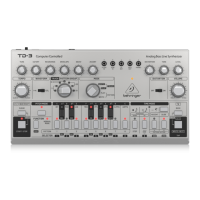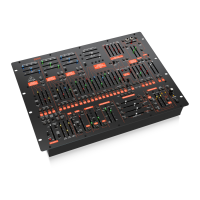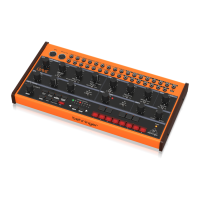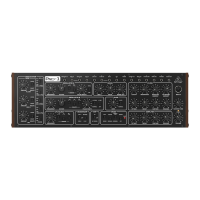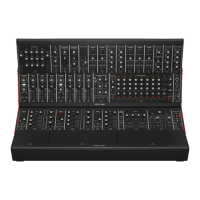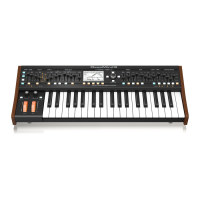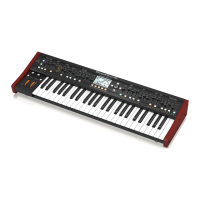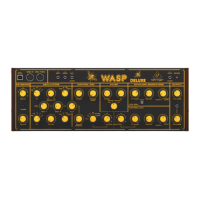19 NEUTRON User Manual
8. Patch Bay
In a patchable semi-modular synthesizer such as the Neutron, inputs and outputs
are independent from one another. It is up to the user to patch the modules
together as they wish. This is dierent from a normalized synthesizer where the
functions are hard-wired together and the user just changes parameters.
Patchable modular synthesizers are more complex to operate but give innite
options. Below is a table of default or normalized routings. Please refer to the
numbering diagram earlier in this document. There follows a block diagram of
the normalized signal ow to show how audio travels through the Neutron.
DEFAULT ROUTINGS
OUTPUT FROM GOES TO THEN INTO
OSC MIX + EXT INPUT +
NOISE
VCF>OD>VCA>DELAY LINE OUT + Headphones
ENV 1 VCA CV
LFO (BIPOLAR) ATT 2 ATT 1
ATTENUATOR 2 PULSE WIDTH 1&2
NOISE SAMPLE AND HOLD
LFO (BIPOLAR) FILTER DEPTH VCF FREQUENCY CV
ENV 2 ENV DEPTH VCF FREQUENCY CV
ASSIGN ATT1 CV
LFO (BIPOLAR) MULT INPUT
ENV 2 INVERT
E. GATE1 E. GATE2 UNLESS OVERRIDDEN
USING E. GATE 2 INPUT
ATTENUATOR FLOW
PW1
PW2
OSC 2
NOISE
OVERDRIVE VCA DELAY
OSC 2
OUTPUT
LFO
ENV 2
ENV DEPTH
MOD DEPTH
OSC MIX
NOISE
SAMPLE
& HOLD
OSC 1
UNI-POLAR
LFO
MIDI
ASSIGN
ENV 1
ENV DEPTH
ATT2
ATT1
ATT1 CV
VCF
EG2 INVERT
BI-POLAR
LFO
MULT IN
MULT 1
MULT 2
VCA BIAS
OSC 1
EXTRNAL
INPUT
8.1 Tips and Tricks of the Patch Bay
1. Patch Sample and Hold out into FREQ MOD in. Turn MOD DEPTH to 12 o’clock.
Then Turn the S&H rate to 3 o’clock and the GLIDE to 12 0’clock. This will give you
a random lter position which glides between lter cuto points.
2. Patch LFO to PW1 and MULT 1 into INVERT IN, then INVERT OUT to PW2 for
opposite direction pulse width modulation. This is a is a variation that sounds
slightly dierent to turning ATTENUATOR 2 (see normalized routings for details).
3. With OSC 1&2 in blend mode, patch LFO to SHAPE 1. Patch MULT 1 into INVERT
IN then INVERT OUT into Shape 2 for opposite direction oscillator shape shifting, a
very powerful sound creation tool.
4. Set both OSC to Tone Mod Shape and ENV 2 to PW1&2 via the Mult with slow
ADSR settings. This gives a rich Pulse Width Modulation (PWM) eect.
5. Patch LFO into ATT 1 IN, then patch ATT1 OUT to DELAY TIME IN. Set a short
delay with the delay mix around 50% and adjust the LFO speed and shape to
create a chorus eect.
6. Patch VCF 1&2 into Sum 1 A&B. Patch the output of SUM 1 into OD In. Set the
lter shape to LPF to create a notch lter.
7. Patch a square wave shape LFO out to the delay time in. Then try ENV2 out
patched to LFO Rate. This sounds like and 80’s computer game.
8. Patch OSC 1 into OSC 2 with OSC SYNC active for frequency modulation
synthesis.
9. Patch LFO into ATT 1 IN, Then ATT 1 into OSC2 with OSC SYNC active. This gives
another style of FM synthesis to experiment with while using both oscillators. Try
changing the position of ATT 1 to hear subtle changes.
10. Patch ASSIGN to ATT1 CV, set ASSIGN to MOD WHEEL, patch ATT1 OUT into OSC
1&2 pitch CV, this way the mod wheel sets the depth of vibrato, with LFO rate/
shape setting the characteristics and ATT2 setting the maximum depth.

